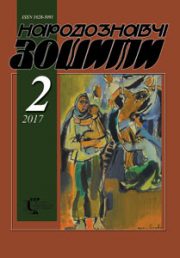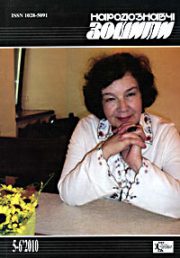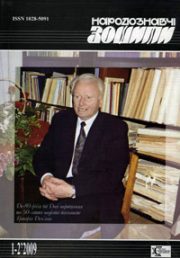The Ethnology Notebooks. 2017, 3 (135), 541–554
UDK 398.9:27](477)
https://doi.org/10.15407/nz2017.03.541
Tarasiuk Iryna Petrivna — junior research fellow
of the department of the modern ethnology
of the Institute of Ethnology of the National Academy of Sciences of Ukraine.
Svobody Avenue 15, 79000, Lviv, Ukraine.
Contacts: Tel. 067-288-72-54, e-mail: tarasyuk007@gmail.com
Abstract. This article is dedicated to an ethnolinguistic research on exclamatory figures of speech with religious meaning, which accompany various emotional states. The study presents a fairly broad spectrum of «religious vocatives» in the paremy genre of Ukrainian folklore. The author concludes that, as compared to other European languages, Ukrainian and Polish languages contain much more exclamatory sayings of religious character. The appellative formulae being analyzed reflect popular religious beliefs, peculiarities of the people’s ethno¬psychological composition, as well as emotional culture.
Keywords: exclamatory figure of speech, exclamatory formula, «religious vocative», saying, appeal, appellation, semantics, popular speech, popular beliefs, religious outlook, emotions, emotional response, paremy, proverb.
Received 11.04.2017
REFERENCES
Arkhiv IN NAN Ukrainy. F. 1. Op. 2. Od. zb. 211a. Ark. 1–312. Dej O. I. Fol’klorni materialy (Pisni z notamy): rukopys. T. 2 [in Ukrainian].
Arkhiv IN NAN Ukrainy. F. 1. Op. 2. Od. zb. 211b. Ark. 1–316. Dej O. I. Fol’klorni materialy (Pisni z notamy): rukopys. T. 3 [in Ukrainian].
Abetka khrystyians’koi nauky i obriadu / skorochene vyd. (2002) Ivano-Frankivs’k. Vyd-vo Ivano-Frankivs’koi teolohichnoi akademii [in Ukrainian].
Halyts’korus’ki narodni prypovidky (3 t), 6 vyp. Zibrav, uporiadkuvav i poiasnyv dr. Ivan Franko. Etnohrafichnyj zbirnyk. L’viv, 1901. T. X; 1905. T. XVI. S. 201–600; 1907. T. XXIII; 1908. T. XXIV. S. 301–600; 1909. T. XXVII. 300 s.; 1910. T. XXVIII. S. 301–600 [in Ukrainian].
HeryliukKupchyns’kyj, P. (1996). Viriu v Boha: propovidi. L’viv. Misioner [in Ukrainian].
Grinchenko, B. (1895–1899). Etnograficheskіe materіaly, sobrannye v Chernigovskoi i sosѣdnikh s nei guberniiakh. Chernigov. Tipografіia Gubernskago Zemstva. Vyp. 1. Razskazy, skazki, predanіia, poslovitcy, zagadki i pr. [in Russian]
Grinchenko, B. (1895–1899). Etnograficheskіe materіaly, sobrannye v Chernigovskoi i sosѣdnikh s nei guberniiakh. Chernigov. Tipografіia Gubernskago Zemstva. T. 3: Pѣsni. 1899 [in Russian].
Zhajvoronok, V. (2006). Znaky ukrains’koi etnokul’tury: slovnykdovidnyk. Kyiv. Dovira [in Ukrainian].
Kostomarov, M. Dvi rus’ki narodnosti. Liajptsih. Ukrains’ka nakladnia, [b. r.]. – Ch. 183–184 [in Ukrainian].
Lepkyj, B. (1991). Mazepa: trylohiia. Motria: povist’. Dzvin. № 2, 3 [in Ukrainian].
Matios, M. (2006). Mister i misis Yu-Ko v kraini ukriv: homerychnyj romansymfoniia. L’viv. Piramida [in Ukrainian].
Narodnaia Bibliia: vostochnoslavianskie etiologicheskie legendy (2004) Sost. i komment. O. V. Belovoi; otv. red. V. Ia. Petrukhin. Moskva. Indrik [in Russian].
Pryjdite poklonimsia: molytovnyk. (1991) Rym [in Ukrainian].
Samchuk, U. (1991). Volyn’. Kudy teche ta richka. Dzvin. № 5, 6 [in Ukrainian].
Samchuk, U. (1991). Mariia. Khronika odnoho zhyttia: roman. Pidhot. tekstu ta pisliamova S. P. Pinchuka.Kyiv. Radians’kyj pys’mennyk [in Ukrainian].
Svientsits’kyj, I. (1912). Pokhoronni holosinia. Etnohrafichnyj zbirnyk. L’viv. Z drukarni NTSh. T. XXXI–XXXII. S. 1–129 [in Ukrainian].
Slipushko, O. (1999). Tlumachnyj slovnyk chuzhomovnykh sliv v ukrains’kij movi. Pravopys. Hramatyka. Kyiv. Krynytsia [in Ukrainian].
Slovnyk biblijnoho bohoslov’ia (1996). Za red. Ksav’ie LeonDiubua. Per. z 2-ho fr. vyd. Zah. red. o. Sofrona Mudroho, ChSVV. L’viv. Misioner [in Ukrainian].
Slovnyk ukrains’koi movy: v 11-ty t. (1970–1980) Kyiv. Naukova dumka. T. 1: A–V. Red. P. J. Horets’kyj, A. A. Buriachok, H. M. Hnatiuk, N. I. Shvydka. Kyiv. Naukova dumka [in Ukrainian].
Slovnyk ukrains’koi movy: v 11-ty t. (1970–1980) Kyiv. Naukova dumka. T. 2: H–Zh.Red. P. P. Dotsenko, L. A. Yurchuk. Kyiv. Naukova dumka [in Ukrainian].
Teologicheskii entciklopedicheskii slovar (2003). Pod red. Uoltera Elvela. Moskva. Dukhovnoe vozrozhdenie [in Russian].
Ukrains’ki prykazky, prysliv’ia i take inshe. (1993). Zbirnyky O. V. Markovycha ta inshykh. Uklav M. Nomys. Kyiv. Lybid’ [in Ukrainian].
Frazeolohichnyj slovnyk ukrains’koi movy (1999). Uklad. V. M. Bilonozhenko ta in. Kyiv. Naukova dumka. – Kn. 1 [in Ukrainian].
Khrystyians’ka etyka: posibnyk dlia uchniv 7 kl. (2000). Ternopil’. Pidruchnyky i posibnyky [in Ukrainian].
Shevchenko, T. (1989). Povne zibrannia tvoriv : u 12 t. Redkol.: Ye. P. Kyryliuk ta in. Kyiv. Naukova dumka. T. 1. Poeziia, 1837–1847 rr. [in Ukrainian].
Shevchenko, T. (1989). Povne zibrannia tvoriv : u 12 t. Redkol.: Ye. P. Kyryliuk ta in. Kyiv. Naukova dumka. T. 2. Poeziia, 1847–1861 rr. [in Ukrainian].
Yarema, Ya. (1937). Ukrains’ka dukhovnist’ v ii kul’turnoistorychnykh vyiavakh . L’viv [in Ukrainian].
Lewicki, R. (2002). Chrześcijaństwo: słownik rosyjsko-polski. Warszawa. Instytut wydawniczy Pax [in Polish].
Wierzbicka, A. (1996). Między modlitwą a przekleństwem: o Jezu! i podobne wyrażenia na tle porównawczym. Etnolingwistyka. Lublin № 8. S. 25–39 [in Polish].







